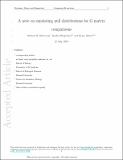A note on simulating null distributions for G matrix comparisons
Abstract
Genetic variances and covariances, summarised in G matrices, are key determinants of the course of adaptive evolution. Consequently, understanding how G matrices vary among populations is critical to answering a variety of questions in evolutionary biology. A method has recently been proposed for generating null distributions of statistics pertaining to differences in G matrices among populations. The general approach facilitated by this method is likely to prove to be very important in studies of the evolution of G . We have identified an issue in the method that will cause it to create null distributions of differences in G matrices that are likely to be far too narrow. The issue arises from the fact that the method as currently used generates null distributions of statistics pertaining to differences in G matrices across populations by simulating breeding value vectors based on G matrices estimated from data, randomising these vectors across populations, and then calculating null values of statistics from G matrices that are calculated directly from the variances and covariances among randomised vectors. This calculation treats breeding values as quantities that are directly measurable, instead of predicted from G matrices that are themselves estimated from patterns of covariance among kin. The existing method thus neglects a major source of uncertainty in G matrices, which renders it anticonservative. We first suggest a correction to the method. We then apply the original and modified methods to a very simple instructive scenario. Finally, we demonstrate the use of both methods in the analysis of a real data set.
Citation
Morrissey , M B , Hangartner , S & Monro , K 2019 , ' A note on simulating null distributions for G matrix comparisons ' , Evolution , vol. Early View . https://doi.org/10.1111/evo.13842
Publication
Evolution
Status
Peer reviewed
ISSN
0014-3820Type
Journal article
Description
MBM is supported by a University Research Fellowship from the Royal Society (London). KM is supported by a Future Fellowship from the Australian Research Council.Collections
Items in the St Andrews Research Repository are protected by copyright, with all rights reserved, unless otherwise indicated.

